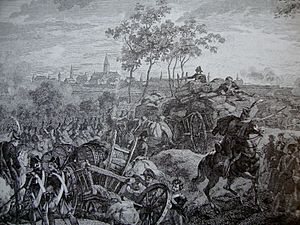Siege of Thionville (1792) facts for kids
Quick facts for kids Siege of Thionville (1792) |
|||||||
|---|---|---|---|---|---|---|---|
| Part of the War of the First Coalition | |||||||
 Print of the 1792 siege of Thionville |
|||||||
|
|||||||
| Belligerents | |||||||
| Commanders and leaders | |||||||
| Strength | |||||||
| 3,000 – 5000 French | 20,000 Austrians 12,000-16,000 French émigrés |
||||||
The siege of Thionville was an important battle during the War of the First Coalition. A siege happens when an army surrounds a town or city to try and take control of it. In this case, the city of Thionville in France was surrounded by enemy forces.
Contents
The Battle for Thionville
The siege of Thionville started on August 24, 1792. A large group of soldiers tried to capture the city. These soldiers were from Austria and also included French Royalist troops. Royalist troops were French people who supported the king and were fighting against the new French government.
Who Was Involved?
The attacking force had about 20,000 Austrian soldiers. They also had between 12,000 and 16,000 French Royalist troops. Their leader was a general named Friedrich Wilhelm, Fürst zu Hohenlohe-Kirchberg.
Inside Thionville, the city was defended by French soldiers. They were led by Georges Félix de Wimpffen. His forces were much smaller, with only 3,000 to 5,000 soldiers.
One famous person among the French Royalist troops was François-René de Chateaubriand. He later became a well-known writer. He was hurt during this battle.
The Fight and Its End
The attackers tried for many weeks to take Thionville. However, the defenders held strong. The attacking armies could not capture the city. On October 16, 1792, they gave up and left. This is called "raising the siege." The French defenders won this important battle.
What Happened After the Siege?
After the victory, the French government, called the National Convention, praised Thionville. They said the city had "deserved well of the fatherland." This meant Thionville had done a great job for France.
To remember this victory, two places in Paris were named after Thionville. These were Place de Thionville (Thionville Square) and Rue de Thionville (Thionville Street).
Remembering the Siege
The story of the siege even inspired art. In 1793, a person named Louis-Emmanuel Nadine created a musical play about the event. It was called Siége de Thionville.

